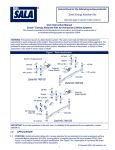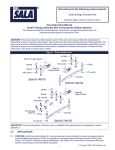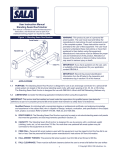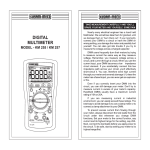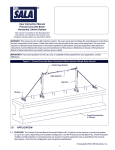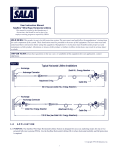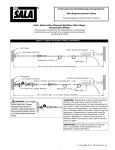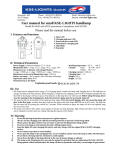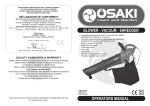Download User Instruction Manual Zorbit™ Energy Absorber Kits
Transcript
User Instruction Manual Zorbit™ Energy Absorber Kits for Horizontal Lifeline Systems This manual is provided as the Maunfacturer’s Instructions, and should be used as part of an employee training program as required by OSHA. WARNING: This product is part of a fall protection system. The users must read and follow the manufacturer’s instructions for each component of the system. These instructions must be provided to the users of this equipment. The users must read and understand these instructions before using this equipment. Manufacturer’s instructions must be followed for proper use and maintenance of this product. Alterations or misuse of this product, or failure to follow instructions, may result in serious injury or death. Figure 1 - Parts Identification 1 © Copyright 2002, DB Industries, Inc. IMPORTANT: If you have questions on the use, care, or suitability of this equipment for your application, contact DBI/SALA. 1.0 1.1 APPLICATION PURPOSE: Zorbit HLL (horizontal lifeline) energy absorber kits are intended to be used as elements within a horizontal lifeline subsystem (HLLSS), forming part of a complete personal fall arrest system (PFAS). See Figure 1 for Zorbit kit numbers and parts identification. See Figure 2 for a description of a personal fall arrest system incorporating a horizontal lifeline subsystem. Figure 2 - Personal Fall Arrest System (PFAS) Incorporating a Horizontal Lifeline System 1.2 LIMITATIONS: The following limits apply to the installation and use of Zorbit HLL energy absorber kits. Other limitations may apply: IMPORTANT: OSHA regulations state that horizontal lifelines shall be designed, installed, and used under the supervision of a qualified person (see below for definition) as part of a complete personal fall arrest system that maintains a safety factor of at least two. Qualified Person: An individual with a recognized degree or professional certificate, and an extensive knowledge and experience in the subject field, who is capable of design, analysis, evaluation, and specification in the subject work, project, or product. Refer to OSHA 1910.66, 1926.32, and 1926.502. A. HORIZONTAL LIFELINE SPAN: Zorbit HLL energy absorbers must only be used for single span horizontal lifeline applications. Multiple span systems using intermediate supports are not allowed. The maximum horizontal lifeline span length is 60 feet when using a single Zorbit HLL energy absorber, or 100 feet when a Zorbit HLL energy absorber is installed on each end of the system. See Figure 3. The span length must be reduced when clearance is limited. See section 3.0 for clearance information. B. SYSTEM CAPACITY: The maximum capacity of horizontal lifeline subsystems (see Figure 2) with Zorbit HLL energy absorbers is two persons. The maximum weight of each person, including tools and clothing, is 310 lbs. 2 Figure 3 - Typical Horizontal Lifeline Installation with Zorbit Kits C. CONNECTING SUBSYSTEM: Each person’s connecting subsystem (see Figure 2) must limit fall arrest forces to 900 lbs. or less. See section 2.5. D. FREE FALL: Rig and use the personal fall arrest system such that the maximum potential free fall does not exceed government regulatory and subsystem manufacturer’s requirements. See section 3.0 and subsystem manufacturer’s instructions for more information. Figure 4 - Swing Fall Hazard E. SWING FALLS: Swing falls occur when the anchorage point is not directly overhead. The force of striking an object in a swing fall may cause serious injury or death. Minimize swing falls by working as directly below the anchorage point as possible. Do not permit a swing fall if injury could occur. See Figure 4. Swing falls will significantly increase the clearance required when a self retracting lifeline or other variable length connecting subsystem is used. If a swing fall situation exists in your application, contact DBI/SALA before proceeding. F. FALL CLEARANCE: There must be sufficient clearance below the worker to arrest a fall before striking the lower level or obstruction. See section 3.0 for required clearance information. G. BODY SUPPORT: Zorbit HLL energy absorbers must only be used with personal fall arrest systems incorporating a full body harness. See Figure 2. H. PHYSICAL AND ENVIRONMENTAL HAZARDS: Use of this equipment in areas with physical or environmental hazards may require additional precautions to reduce the possibility of injury to the user or damage to the equipment. Hazards may include, but are not limited to; heat, chemicals, corrosive environments, high voltage power lines, gases, moving machinery, and sharp edges. Contact DBI/SALA if you have questions about using this equipment where physical or environmental hazards exist. I. TRAINING: This equipment must be installed and used by persons trained in the correct application and use of this equipment. See section 4.0. 3 1.3 2.0 APPLICABLE STANDARDS: Refer to national standards, including ANSI Z359.1, ANSI A10.14, and local, state, and federal (OSHA 1910.66 and 1926.502) requirements for more information on personal fall arrest systems and associated components. SYSTEM REQUIREMENTS 2.1 COMPATIBILITY OF COMPONENTS AND SUBSYSTEMS: Zorbit HLL energy absorbers and Zorbit kit components must only be used with fall arrest system components, subsystems, or elements that have been designated by the manufacturer as suitable for such use, and comply with these instructions. Non-compatible components and subsystems could affect the safety and reliability of the complete system. 2.2 COMPATIBILITY OF CONNECTORS: Connectors used to attach to the HLL (hooks, carabiners, D-rings) must support at least 5,000 lbs. Connectors and attachment elements must be compatible in size, shape, and strength. Non-compatible connectors may unintentionally disengage (roll-out). Only self locking snap hooks and carabiners may be used to connect directly to the horizontal lifeline. Do not use non-locking connectors with this system. Connectors used to attach the horizontal lifeline to end anchors must be compatible with the connection point. The connection must be positive; and, with connecting elements, capable of sustaining a 5,000 lbs. load without failure. 2.3 STRUCTURE LOAD REQUIREMENTS: Structural anchorage points must be rigid and capable of supporting at least 5,000 lbs. along the axis of the horizontal lifeline. Anchorages must also support at least 3,600 lbs. applied in all potential directions of fall arrest that are perpendicular to the axis of the horizontal lifeline. See Figure 5. Figure 5 - Anchorage Strength Requirements WARNING: Anchorages must be rigid. Large deformations of the anchorage will affect system performance, and may increase the required fall clearance below the system, which could result in serious injury or death. 2.4 LIFELINE WIRE ROPE REQUIREMENTS: DBI/SALA requires as a minimum 3/8 inch diameter, 7x19, galvanized aircraft cable. The system performance information contained in this manual is based on using this wire rope type. Larger cable sizes with equal or greater strength and stiffness properties may also be used. Do not use synthetic lifelines. NOTE: Wire rope cable clips provided with Zorbit kit 7401033 are for use with 3/8 inch diameter wire rope only. 2.5 CONNECTING SUBSYSTEM REQUIREMENTS: The connecting subsystem is the portion of the personal fall arrest system that is used to connect between the horizontal lifeline subsystem and harness fall arrest attachment element (see Figure 2). For systems incorporating Zorbit HLL energy absorbers, each connecting subsystem must limit forces applied to the horizontal lifeline to 900 lbs. or less. 3.0 OPERATION AND USE WARNING: Do not alter or intentionally misuse this equipment. Use caution when using this equipment around moving machinery, electrical and chemical hazards, and sharp edges. WARNING: Consult your doctor if there is reason to doubt your fitness to absorb the impact from a fall arrest. Age and fitness can affect your ability to withstand fall arrest forces. Pregnant women and minors must not use this system. 4 3.1 BEFORE EACH USE inspect this equipment according to steps listed in section 5.2. Do not use this equipment if inspection reveals an unsafe or defective condition. Plan your use of the fall protection system prior to exposing workers to dangerous situations. Consider all factors affecting your safety before using this system. A. Read and understand all manufacturer’s instructions for each component of the personal fall arrest system. All DBI/SALA harnesses and connecting subsystems are supplied with separate user instructions. Keep all instructions for future reference. B. Review sections 1.0 and 2.0 to ensure system limitations and other requirements have been adhered to. Review applicable information regarding system clearance criteria, and ensure changes have not been made to the system installation (i.e. length), or occurred at the job site, that could affect the required fall clearance. C. Do not use the system if changes are required. 3.2 HORIZONTAL LIFELINE INSTALLATION WHEN USING DBI/SALA CONNECTING SUBSYSTEMS: Figure 3 shows typical horizontal lifeline system installations. When using an energy absorbing lanyard to connect to the system, the end anchorages must be located at a height which will limit the free fall to six feet. When using an SRL (self retracting lifeline) to connect to the system, the end anchorages must be located above the worker. The SRL, when fully retracted, must be above the harness attachment level. The HLL system should be positioned at a level that will minimize free fall, but allow ease of use. The lifeline should be positioned near the work location to minimize swing fall hazards (see Figure 4). The connecting subsystem length should be kept as short as possible to reduce the potential free fall and required clearance distance. Both anchorages must be installed at approximately the same elevation, so that the HLL system is not sloped more than five degrees. IMPORTANT: Lifeline installation must be supervised by a qualified person. See section 1.2. Step 1. Determine the locations of the end anchorages and evaluate their strengths in accordance with section 2.3. Determine the span length and evaluate the required clearance using Figure 7 or 8. Figures 7 and 8 apply to one or two users connected to the system. Step 2. If possible, assemble the HLL system on the ground before attaching to the anchorages using hardware provided, or with customer supplied connecting components. Connectors must meet the requirements specified in section 2.2. Typical lifeline assemblies are shown in Figure 3. See section 2.4 for wire rope specifications. Ensure all fasteners are properly tightened. Leave slack in the turnbuckle to allow for system tensioning. IMPORTANT: Lifeline assemblies longer than 60 feet require a Zorbit HLL energy absorber on each lifeline end. Step 3. 3.3 Figure 6 - Installation of Thimble and Clips Install the lifeline assembly to structural anchorage attachment points. See section 2.3 for anchorage specifications. Tension the lifeline until taut. The cable deflection at mid-span must be six inches or less, with no weight on the HLL. See Figure 6 for installation of 3/8 inch thimble and cable clips supplied with Zorbit kit 7401033. HORIZONTAL LIFELINE INSTALLATION WHEN USING OTHER THAN DBI/SALA CONNECTING SUBSYSTEMS: The lifeline may be installed as described in section 3.2 above, however, because DBI/SALA cannot predict the performance of non-DBI/SALA subsystem components, Figures 7 and 8 do not apply. The required clearance must be determined by using the lifeline deflection data given in Figure 9, and subsystem performance provided by the manufacturer. Figures 10 and 11 show clearance factors to consider. 5 Figure 7 - Clearance Evaluation using DBI/SALA Energy Absorbing Lanyards Figure 8 - Clearance Evaluation using DBI/SALA Self Retracting Lifelines 6 3.4 OPERATION: A. PERSONAL FALL ARREST SYSTEM COMPONENTS: Inspect and don the full body harness according to manufacturer’s instructions. Attach the connecting subsystem (energy absorbing lanyard or SRL) to the dorsal connection on the harness. B. CONNECTING TO THE HLL SYSTEM: Approach the work area using the appropriate access equipment. Secure the personal fall arrest system by attaching the energy absorbing lanyard or SRL to the HLL. Connectors must meet all compatibility and strength requirements. NOTE: Due to their weight, SRL’s may require a rolling connection (pulley) to the lifeline. C. HAZARDOUS SITUATIONS: Do not take unnecessary risks, such as jumping or reaching too far from the edge of the working surface. Do not allow the connecting subsystem to pass under arms or between feet. To avoid inadequate clearance, do not climb above the HLL. To avoid swing fall hazards, do not work too far from either side of the HLL. D. TWO PERSONS CONNECTED TO THE HLL: When a person falls while connected to the HLL, the system will deflect. If two persons are connected to the same HLL, and one person falls, the second person may be pulled off the working surface due to deflection. The potential for the second person falling increases as the HLL span length increases. The use of independent HLL systems for each person, or shorter span length, is recommended to minimize the potential of the second person falling. E. FREE FALL: The personal fall arrest system must be rigged to limit free falls to six feet or less when using an energy absorbing lanyard, or such that the SRL is overhead and without slack, according to OSHA requirements. F. SHARP EDGES: Avoid working where the connecting subsystem or other system components will be in contact with, or Figure 9 abrade against, unprotected sharp edges. If working around sharp edges is unavoidable, a protective cover must be used to prevent cutting of the PFAS components. G. IN THE EVENT OF A FALL: The responsible party must have a rescue plan and the ability to implement a rescue. Tolerable suspension time in a full body harness is limited, so a quick rescue is critical. IMPORTANT: Use care when handling an expended Zorbit energy absorber. The tearing of the energy absorber material produces extremely sharp edges. 7 Figure 10 - Clearance Evaluation Factors- Energy Absorbing Lanyards Figure 11 - Clearance Evaluation Factors - Self Retracting Lifelines 8 H. RESCUE: With the number of potential scenarios for a worker requiring rescue, an on site rescue team is beneficial. The rescue team is given the tools, both in equipment and techniques, so it can perform a successful rescue. Training should be provided on a periodic basis to ensure rescuers proficiency. 3.5 4.0 4.1 5.0 5.1 SYSTEM REMOVAL: When no longer required, the HLL system should be removed from the job site. To slacken the HLL, loosen the turnbuckle until tension is removed from the wire rope. Disconnect the HLL system from the anchorages. Ensure there are no knots or kinks in the wire rope before storage. TRAINING It is the responsibility of all users of this equipment to understand these instructions, and are trained in the correct installation, use, and maintenance of this equipment. These individuals must be aware of the consequences of improper installation or use of this equipment. This user manual is not a substitute for a comprehensive training program. Training must be provided on a periodic basis to ensure proficiency of the users. INSPECTION FREQUENCY BEFORE EACH INSTALLATION: Inspect the Zorbit HLL energy absorber, kit components, and other system components according to these or other manufacturer’s instructions. System components must be formally inspected by a qualified person (other than the user). Formal inspections should concentrate on visible signs of deterioration or damage to the system components. Items found to be defective must be replaced. Do not use components if inspection reveals an unsafe or defective condition. Record results of each inspection in the inspection and maintenance log in section 9.0 of this manual. INSTALLED SYSTEMS: An inspection of the HLL system by a qualified person must be completed after the system is installed. The system must be periodically inspected by a qualified person when left installed for an extended period. Periodic formal inspections should be performed at least monthly, or more frequently when site conditions and use warrant. Inspections of installed systems should include the inspection steps listed in section 5.2. ANNUALLY: A Qualified Person shall inspect the entire system including the anchorage points. Inspect for deterioration or damage. Items found to be defective must be replaced. Do not use components if inspection reveals an unsafe or defective condition. Record the results of each inspection in the Inspection and Maintenance Log section 9.0 of this manual. BEFORE EACH USE: Before each use the user shall inspect the Zorbit HLL energy absorber, kit components and other system components. Inspect according to section 5.2. Items found to be defetive must be replaced before using system. 5.2 INSPECTION STEPS: Step 1. Inspect the turnbuckle for damage. Ensure sufficient threads are engaged into the turnbuckle body. Look for any cracks or deformities in the metal. Inspect metal components for rust or corrosion that may affect their strength or operation. Step 2. Inspect the wire rope for rust, corrosion, broken wires, or other obvious faults. Inspect the HLL for proper tension. See sections 3.2 and 3.3. Inspect all hardware (fasteners, shackles, wire rope cable clips, etc.) securing the HLL assembly to ensure they are present and properly installed. Step 3. Inspect the Zorbit HLL energy absorber for extension or deformities. There should be no tearing of the metal between holes in the Zorbit coiled section. Extended Zorbit HLL energy absorbers must be removed from service and destroyed, or marked for training only. Inspect securing hardware for strength and function. Step 4. Inspect Zorbit label. The label must be present and fully legible. See section 8.0. Replace label if missing or illegible. 9 IMPORTANT: If this equipment is subjected to the forces of a fall arrest, it must be removed from service and destroyed, or returned to DBI/SALA for inspection or repair. 5.4 If inspection reveals an unsafe or defective condition, remove unit from service and destroy, or contact DBI/ SALA for possible repair. 5.5 USER EQUIPMENT: Inspect harnesses and energy absorbing lanyards or SRL’s used with the HLL system according to manufacturer’s instructions. 6.0 MAINTENANCE, SERVICE, STORAGE 6.1 The Zorbit kit components require no scheduled maintenance, other than repair or replacement of items found defective during inspection. See section 5.0. If components become heavily soiled with grease, paint, or other substances, clean with appropriate cleaning solutions. Do not use caustic chemicals that could damage system components. 6.2 USER EQUIPMENT: Maintain, service, and store user equipment according to manufacturer’s instructions. 7.0 7.1 SPECIFICATIONS MATERIALS: Zorbit Energy Absorber: Stainless steel Bolts: Grade 5 or Grade 8 zinc plated steel Nuts: Zinc plated steel Shackles: Galvanized steel, 5,000 lbs. minimum tensile strength Thimbles: Galvanized steel Turnbuckle: Galvanized steel, 5,000 lbs. minimum tensile strength Cable Clips: Galvanized steel 7.2 ENERGY ABSORBER PERFORMANCE: Peak Dynamic Pullout Load: 2,500 lbs. Average Dynamic Pullout Load: 2,000 lbs. Maximum Pullout: 48.5 inches Minimum Tensile Strength: 5,000 lbs. Patents Pending 8.0 8.1 LABELING This label must be present and fully legible: 10 9.0 INSPECTION AND MAINTENANCE LOG DATE OF MANUFACTURE: _______________________________________________________________________ MODEL NUMBER: ______________________________________________________________________________ DATE PURCHASED: ________________________________________________________________________________ INSPECTION DATE INSPECTION ITEMS NOTED CORRECTIVE ACTION Approved By: Approved By: Approved By: Approved By: Approved By: Approved By: Approved By: Approved By: Approved By: Approved By: Approved By: Approved By: 11 MAINTENANCE PERFORMED USA Canada 3965 Pepin Avenue Red Wing, MN 55066-1837 Toll Free: 800-328-6146 Phone: (651) 388-8282 Fax: (651) 388-5065 www.salagroup.com 260 Export Boulevard Mississauga, Ontario L5S 1Y9 Toll Free: 800-387-7484 Phone: (905) 795-9333 Fax: (905) 795-8777 I S O 9001 Certificate No. FM 39709 12 Form: 5911863 Rev: B












